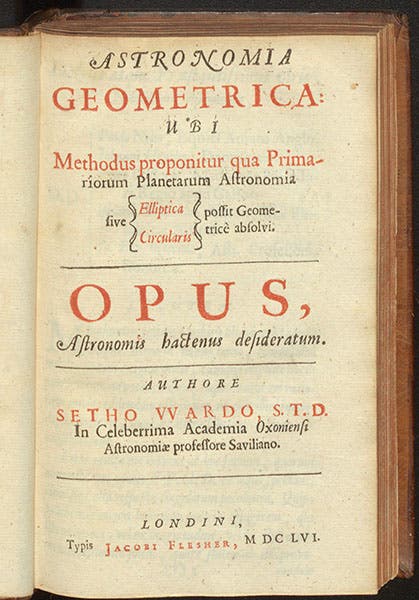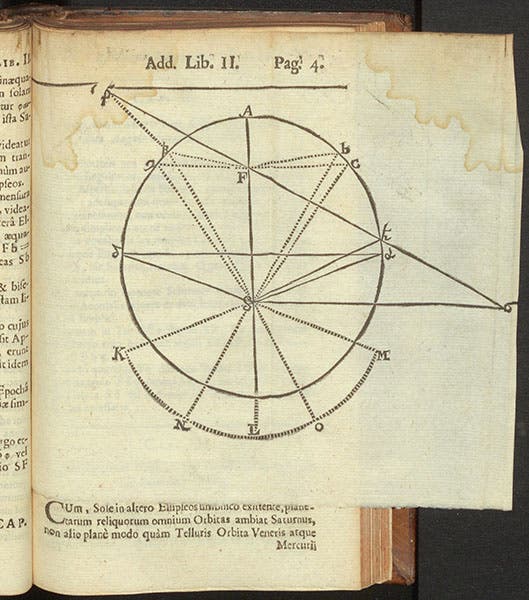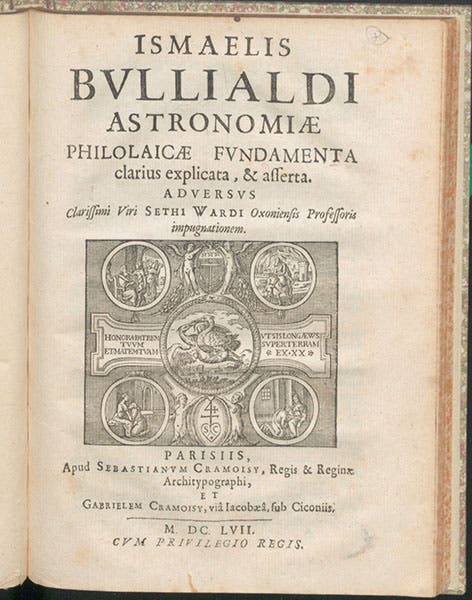Scientist of the Day - Seth Ward
Seth Ward, an English mathematician and astronomer, was born Apr. 5, 1617. He taught at Oxford and became the third Savilian Professor of Astronomy there in 1649. The Savilian Professorships (in astronomy and geometry) had been established in 1619, and the individuals who filled the chair were unusually competent (compared to many named chairs at the time) – Ward was preceded by John Bainbridge and John Greaves, and succeeded by Christopher Wren in 1660. Bainbridge was one of the first defenders of Keplerian astronomy in England, which seems to have rubbed off on Ward. Johannes Kepler had proposed his first two laws in 1609, asserting that the planet Mars moves in an elliptical orbit about the Sun, with the Sun at one of the foci, and that it moves faster when near the Sun according to a simple law, the area law. In succeeding works, Kepler broadened this to include all the planets; he further took a physical approach to astronomy, trying to find the physical cause (a magnetic force in the Sun) that explained his laws; and he completely discarded that oldest of astronomical axioms, the belief that heavenly bodies must move with uniform circular motions. Perhaps most significantly, he used his laws (the period law emerged in 1619) to compile a set of tables, the Rudolphine Tables (1627) that were more accurate than previous tables by an order of magnitude.
Kepler's laws made slow inroads into France and England, but his tables were undeniably better than any rivals and came into common use. Not all users were happy with Kepler's insistence on physical causes, nor with his abandonment of circular motion, nor was everyone ready to accept the Copernican basis of Keper's astronomy. In 1645, Ismael Boulliau, a French astronomer, published a massive work, the Astronomia philolaica. Boulliau was a Copernican (Philolaus was the first “Copernican,” an ancient Pythagorean), but Boulliau insisted that astronomy is a branch of geometry (it had always been so) and not a branch of physics. But he had no doubt that the orbits of the planets were elliptical, not circular. His book was the first major Keplerian treatise in Europe, but Boulliau tried to explain Keplerian ellipses geometrically, rejecting a force in the Sun as their cause, and he further attempted to generate those geometrical ellipses with circles, utilizing the fact that an ellipse is a section of a cone at an oblique angle, and a planet moving on an ellipse is in a sense moving in an infinite series of circles up and down the cone.
So let’s bring Ward back in. Ward accepted Keperian ellipses himself, but he was a better geometer than Boulliau and very critical of the methods of his French counterpart. In 1653, he published In Ismaelis Bullialdi astro-nomiae philolaicae fundamenta inquisitio brevis, a "Short Inquisition" into Boulliau's Astronomia philolaica, in which he directly attacked Boulliau’s geometrical methods and the accuracy of his observations. He followed that up with his Astronomia geometrica (1656), in which he provided his own geometrical explanation for elliptical orbits. In one of the diagrams of that work (fourth image), you can see an elliptical orbit, with the Sun (S) at one of the foci. Since an ellipse has two foci, there is an "empty focus,", here labelled F, and Ward thought that while the planets speed up and slow down with reference to the Sun, they might move uniformly with respect to the empty focus, thus preserving uniform circular motion for astronomy.
Boulliau did not take such criticism lightly, and he responded in 1657 with his Astronomiæ philolaicæ fvndamenta clariùs explicata, & asserta aduersùs clariss. viri Sethi Wardi ... impugnationem. We provide the entire title (and show you the title page, fifth image) so that we can translate it in full: “The fundamental principles of the Astronomia philolaica clearly explained, and asserted against the assault of the distinguished Seth Ward.” Here Boulliau responded to some of the criticism with modifications, and took issue with the rest of the “assault.” The details are too technical to pursue here, but we are pleased as a Library to have all of these works in our collections, as well as Boulliau’s Astronomia philolaica of 1645, and every work of Kepler you would ever want to see.
Like many of his contemporary professors after the Restoration in 1660 (Isaac Barrow and John Wilkins come to mind), Ward exchanged the academic life for the clerical, becoming first Bishop of Exeter and then Bishop of Salisbury. He died on Jan. 6, 1689, and was buried in Salisbury Cathedral, where (as a bishop) he has a prominent memorial stone (sixth image).
There are many oil portraits of Ward, but all with identical poses, either by or after one by John Greenhill, ca 1675. The one we show as our first image is at Trinity College, Oxford.
William B. Ashworth, Jr., Consultant for the History of Science, Linda Hall Library and Associate Professor emeritus, Department of History, University of Missouri-Kansas City. Comments or corrections are welcome; please direct to ashworthw@umkc.edu.












